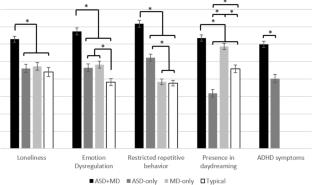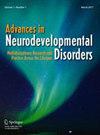Shared Challenges and Cooccurrence of Maladaptive Daydreaming and Autism Spectrum Disorder
Abstract
Abstract
Objectives
Maladaptive daydreaming (MD) is a condition involving excessive, highly immersive daydreaming. We conducted a cross-sectional investigation of the occurrence of MD in adults with autism spectrum disorder (ASD) and the overlapping characteristics between the conditions.
Methods
We surveyed broad ASD traits, MD symptoms, sense of presence in daydreaming, loneliness, emotion regulation difficulties, and restricted and repetitive behaviors in a sample of 609 adults without a diagnosis of ASD and a sample of 235 adults with a diagnosis of ASD. We also examined the occurrence of MD in the ASD sample using a structured interview.
Results
A path analysis revealed that broad ASD traits were associated with MD symptoms via the mediating effects of loneliness and emotion regulation difficulties. Moreover, 43% of adults with ASD reported experiences of MD, and hierarchical regression analysis revealed that these symptoms were associated with loneliness and emotion regulation difficulties. A multivariate analysis of covariance to compare groups showed that individuals with co-occurring ASD and MD scored highest on measures of loneliness, emotion regulation difficulties, restricted and repetitive behaviors, and sense of presence in daydreaming, compared to individuals with either ASD or MD alone or those with neither condition.
Conclusions
This research indicates that experiences of MD are common among adults with ASD and are associated with high degrees of loneliness and emotion regulation difficulties. Future research should further explore the unique presentation of MD in ASD and the associated challenges.


 求助内容:
求助内容: 应助结果提醒方式:
应助结果提醒方式:


